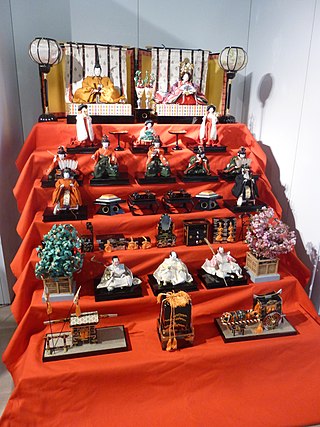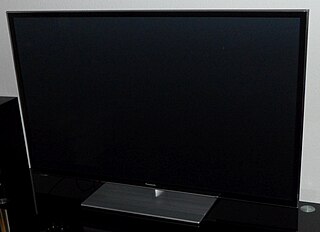Related Research Articles

The Graphics Interchange Format is a bitmap image format that was developed by a team at the online services provider CompuServe led by American computer scientist Steve Wilhite and released on June 15, 1987.

Not to be confused with Hanamatsuri.

Chroma subsampling is the practice of encoding images by implementing less resolution for chroma information than for luma information, taking advantage of the human visual system's lower acuity for color differences than for luminance.

A plasma display panel (PDP) is a type of flat-panel display that uses small cells containing plasma: ionized gas that responds to electric fields. Plasma televisions were the first large flat-panel displays to be released to the public.
Pixel art is a form of digital art drawn with graphical software where images are built using pixels as the only building block. It is widely associated with the low-resolution graphics from 8-bit and 16-bit era computers, arcade machines and video game consoles, in addition to other limited systems such as LED displays and graphing calculators, which have a limited number of pixels and colors available. The art form is still employed to this day by pixel artists and game studios, even though the technological limitations have since been surpassed.

The display resolution or display modes of a digital television, computer monitor, or other display device is the number of distinct pixels in each dimension that can be displayed. It can be an ambiguous term especially as the displayed resolution is controlled by different factors in cathode ray tube (CRT) displays, flat-panel displays and projection displays using fixed picture-element (pixel) arrays.
Pixels per inch (ppi) and pixels per centimetre are measurements of the pixel density of an electronic image device, such as a computer monitor or television display, or image digitizing device such as a camera or image scanner. Horizontal and vertical density are usually the same, as most devices have square pixels, but differ on devices that have non-square pixels. Pixel density is not the same as resolution — where the former describes the amount of detail on a physical surface or device, the latter describes the amount of pixel information regardless of its scale. Considered in another way, a pixel has no inherent size or unit, but when it is printed, displayed, or scanned, then the pixel has both a physical size (dimension) and a pixel density (ppi).

The X68000 is a home computer created by Sharp Corporation. It was first released in 1987 and sold only in Japan.

The FM Towns is a Japanese personal computer built by Fujitsu from February 1989 to the summer of 1997. It started as a proprietary PC variant intended for multimedia applications and PC games, but later became more compatible with IBM PC compatibles. In 1993, the FM Towns Marty was released, a game console compatible with existing FM Towns games.

Comic Market, more commonly known as Comiket or Comike, is a semiannual doujinshi convention in Tokyo, Japan. A grassroots market focused on the sale of doujin (self-published) works, Comiket is a not-for-profit fan convention administered by the volunteer-run Comic Market Preparatory Committee (ComiketPC). Inaugurated on 21 December 1975 with an estimated 700 attendees, Comiket has since grown to become the largest fan convention in the world, with an estimated turnstile attendance of 750,000 in 2019. Comiket is typically held at Tokyo Big Sight in August and December, with the two events distinguished as Summer Comic Market and Winter Comic Market, respectively.

In computing, an avatar is a graphical representation of a user, the user's character, or persona. Avatars can be two-dimensional icons in Internet forums and other online communities, where they are also known as profile pictures, userpics, or formerly picons. Alternatively, an avatar can take the form of a three-dimensional model, as used in online worlds and video games, or an imaginary character with no graphical appearance, as in text-based games or worlds such as MUDs.

Dress-up is a children's game in which costumes or clothing are put on a person or on a doll, for role-playing or aesthetics purposes. In the UK the game is called dressing up. In the mid-1990s, dress-up games also became a video game genre in which customizing a virtual character's appearance is the primary focus.

Licca-chan is a Japanese fashion doll launched on July 4, 1967 by Takara, enjoying the same kind of popularity in Japan as the Barbie series does in the United States. Takara had sold over 48 million Licca-chan dolls as of 2002, and over 53 million as of 2007. Licca-chan was created by former shōjo manga artist, Miyako Maki.
RPG Maker, known in Japan as RPG Tsukūru, is a series of programs for the development of role-playing video games (RPGs) with story-driven elements, created by the Japanese group ASCII, succeeded by Enterbrain. The Japanese name, Tsukūru, is a pun mixing the Japanese word tsukuru (作る), means "make" or "create", with tsūru (ツール), the Japanese transliteration of the English word "tool".

Stardoll is a browser-based game from Glorious Games. One of the world's largest online fashion communities, Stardoll has reached over 400 million users as of January 2016.

Pixiv is a Japanese online community for artists. It was first launched as a beta test on September 10, 2007, by Takahiro Kamitani and Takanori Katagiri. Pixiv Inc. is headquartered in Sendagaya, Shibuya, Tokyo, Japan. As of January 2024, the site consists of over 100 million members, over 115 million illustration and manga and over 21 million novel work posted. Pixiv aims to provide a place for artists to exhibit their illustrations and get feedback via a rating system and user comments. Works are organized in an extensive tag structure which forms the backbone of the website.

Image editing encompasses the processes of altering images, whether they are digital photographs, traditional photo-chemical photographs, or illustrations. Traditional analog image editing is known as photo retouching, using tools such as an airbrush to modify photographs or editing illustrations with any traditional art medium. Graphic software programs, which can be broadly grouped into vector graphics editors, raster graphics editors, and 3D modelers, are the primary tools with which a user may manipulate, enhance, and transform images. Many image editing programs are also used to render or create computer art from scratch. The term "image editing" usually refers only to the editing of 2D images, not 3D ones.

Ultraman Tiga is a fictional superhero from the 1996 Ultra Series, Ultraman Tiga, which ended a 15 year long hiatus of live-action shows produced in Japan after Ultraman 80 ended in 1981. In the series, the titular character's body bonded with Daigo Madoka, a man who was a descendant of Ultra Ancient Civilization to fight against monstrous threats during the series' course. Tiga's case is regarded as a "human Ultraman", due to his host Daigo controlling his body instead of Tiga being in control of himself. Following the destruction of the dark ruler Gatanothor, Daigo lost his ability to transform into Tiga, signifying that the ancient warrior's role on Earth was over.
Live2D is an animation technique used to animate static images—usually anime-style characters—that involves separating an image into parts and animating each part accordingly, without the need of frame-by-frame animation or a 3D model. This enables characters to move using 2.5D movement while maintaining the original illustration.

Friendship dolls,Japanese friendship dolls, or Japanese ambassador dolls and the American blue-eyed dolls, were dolls sent between Japan and the United States in 1927. The dolls were meant to improve the deteriorated relationship between Japan and America that had resulted from the Immigration Act of 1924, which prohibited East Asians from immigrating to the United States and sparked anti-Japanese exclusion movements in California and other parts of the US. The Friendship dolls were meant to inspire children to cultivate friendship with the children of the other country, rather than to initiate specific political or legal changes.
References
- ↑ "Tetra Chroma Inc". tetrachroma.co.jp. Retrieved May 6, 2020.
- 1 2 3 "株式会社 テトラクローマ". Green Japan.
- ↑ "つくってあそべる画像メーカーPicrew(ピクルー)正式リリースのお知らせ". tetrachroma.co.jp. Retrieved December 27, 2018.
- ↑ Leishman, Rachel (May 27, 2020). "What Is This New Picrew Avatar Trend?". The Mary Sue . Abrams Media. Archived from the original on November 1, 2020. Retrieved December 18, 2020.
- 1 2 "Picrewの遊び方 – Picrewサポート" (in Japanese). Retrieved March 11, 2021.
- ↑ "Picrew 利用規約 – Picrewサポート" (in Japanese). Retrieved March 11, 2021.
- ↑ "Picrew|The make-and-play image maker". Picrew. Retrieved 2023-12-19.
- ↑ "How To Create Picrew Account - Tech Insider Lab". 2023-01-30. Retrieved 2024-06-01.
- ↑ "TikTok craze: How to make those animated Picrew avatars of yourself". CNET. Retrieved 2024-06-01.